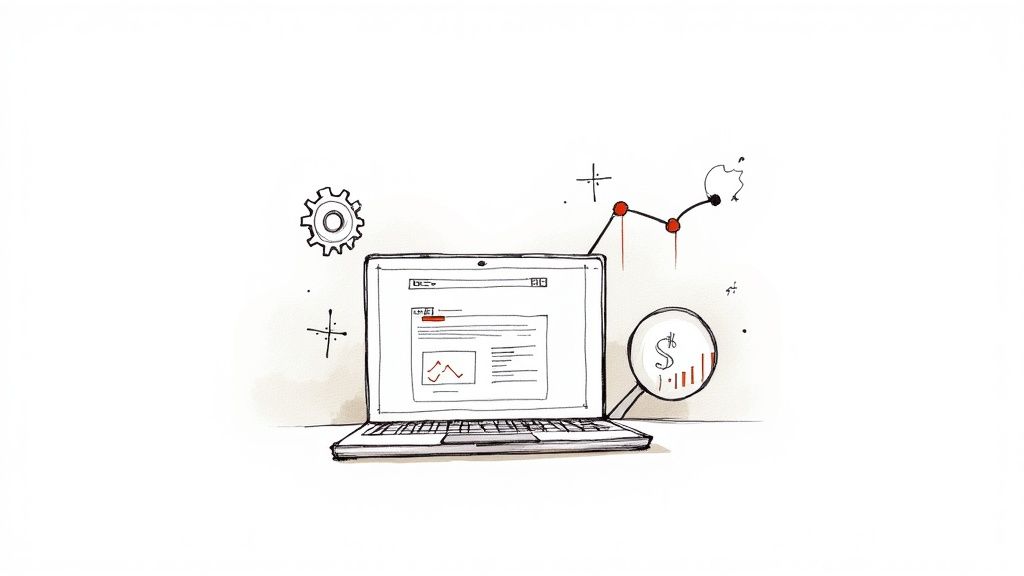The best optimization Google Ads can offer isn't a one-and-done setup; it's a relentless process of fine-tuning. This is where you turn a decent campaign into a true profit-generating machine by constantly testing, learning, and tweaking your approach. It’s this discipline that makes the difference between accounts that just about break even and those that deliver predictable, significant revenue.
Why Continuous Google Ads Optimization Matters
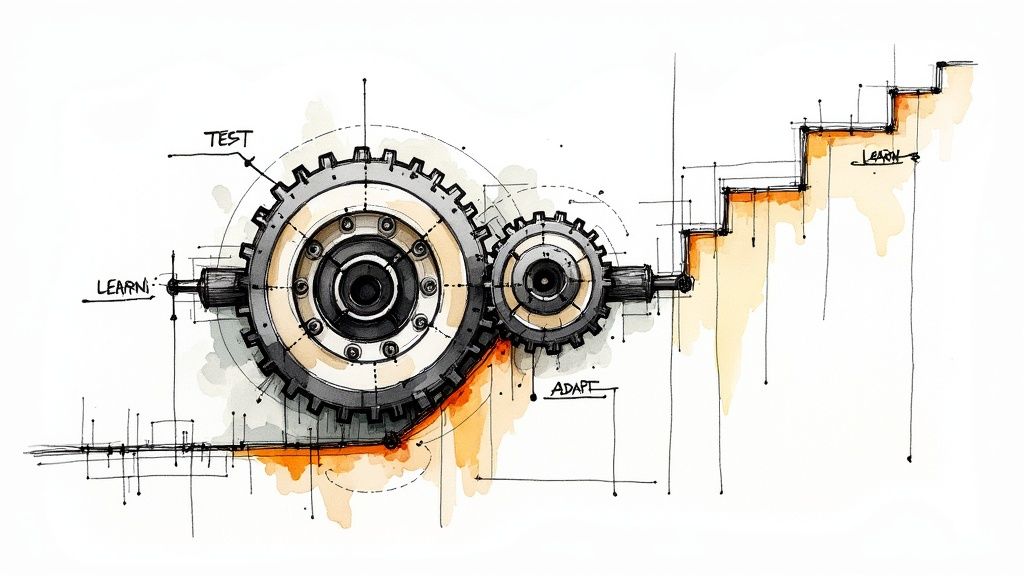
If you treat Google Ads like a "set it and forget it" tool, you’re basically lighting money on fire. The digital advertising ecosystem is in constant flux. Competitors adjust their bids, consumer search behavior evolves, and Google’s algorithm updates can shift the landscape overnight. Ongoing optimization is your strategic advantage, keeping your campaigns sharp, efficient, and profitable.
The ultimate goal is to consistently improve your Return On Ad Spend (ROAS). That means actively managing the core pillars of a high-performing account.
- Precise Keyword Targeting: This involves more than just picking keywords. It means regular pruning of underperforming terms, mining search query reports for new opportunities, and understanding user intent behind every search.
- Intelligent Bidding: Your bidding strategy must be a direct reflection of your business objectives. Whether you’re chasing conversions, maximizing revenue, or aiming for a specific cost-per-acquisition (CPA), your bid strategy is the engine that drives you toward that goal.
- Compelling Ad Creative: Relentless A/B testing of headlines, descriptions, and calls-to-action is non-negotiable. The aim is to discover the precise messaging that resonates with your target audience and compels them to click.
- Seamless User Journey: The experience from the ad click to the landing page and through to the final conversion must be frictionless. Every obstacle is a potential lost sale.
The Financial Impact of Small Improvements
Because of the sheer scale of the Google Ads ecosystem, even fractional improvements can have a massive financial impact. According to Statista, Google's advertising revenue reached an astounding $73.8 billion in just the first quarter of 2024. When that much money is in play, incremental gains in your click-through rate (CTR) or conversion rate (CVR) translate directly into significant boosts to your bottom line.
Optimization is a continuous loop of testing, learning, and adapting. It transforms an account from a simple traffic source into a reliable revenue generator by systematically improving every component of your campaign.
Given the constant effort it takes to stay on top of the Google Ads platform, many businesses decide to team up with a specialized PPC company to keep their campaigns running at peak performance. This ensures that a team of experts is dedicated to navigating the platform's complexities and updates.
Refining Your Keyword and Negative Keyword Strategy
If you want to get serious about optimization Google Ads, you have to get laser-focused on your keywords. It’s time to move past a broad, generic keyword list that attracts window shoppers and start building one that brings in genuinely interested buyers.
The modern best practice is building tightly-themed ad groups, now often referred to as Single Keyword Ad Groups (SKAGs) or Single Theme Ad Groups. The principle is that every keyword within an ad group should share a very precise user intent, allowing for hyper-relevant ad copy.
For example, a business selling athletic footwear should avoid a single ad group for "running shoes." Instead, create dedicated ad groups for long-tail keywords like "men's trail running shoes for flat feet" or "lightweight marathon racing shoes." These longer, more specific phrases almost always have lower competition, higher intent, and a significantly better conversion rate.
Uncovering High-Intent Long-Tail Keywords
Finding these golden long-tail keywords is an ongoing discovery process. The primary tool for this is the Search Terms Report within your Google Ads account. It reveals the exact queries people used that triggered your ads, offering a direct line into your customers' minds.
You can also leverage tools like Google Keyword Planner, AnswerThePublic, or Ahrefs to find question-based queries and related terms your competitors might be overlooking.
The core ideas behind finding great keywords are the same for paid ads and organic search. If you want to really nail this, check out this excellent resource on keyword research in SEO. Aligning your paid and organic keyword strategies creates a powerful one-two punch for your marketing.
This infographic really drives home how much of an impact smart keyword choices can have on your campaign.
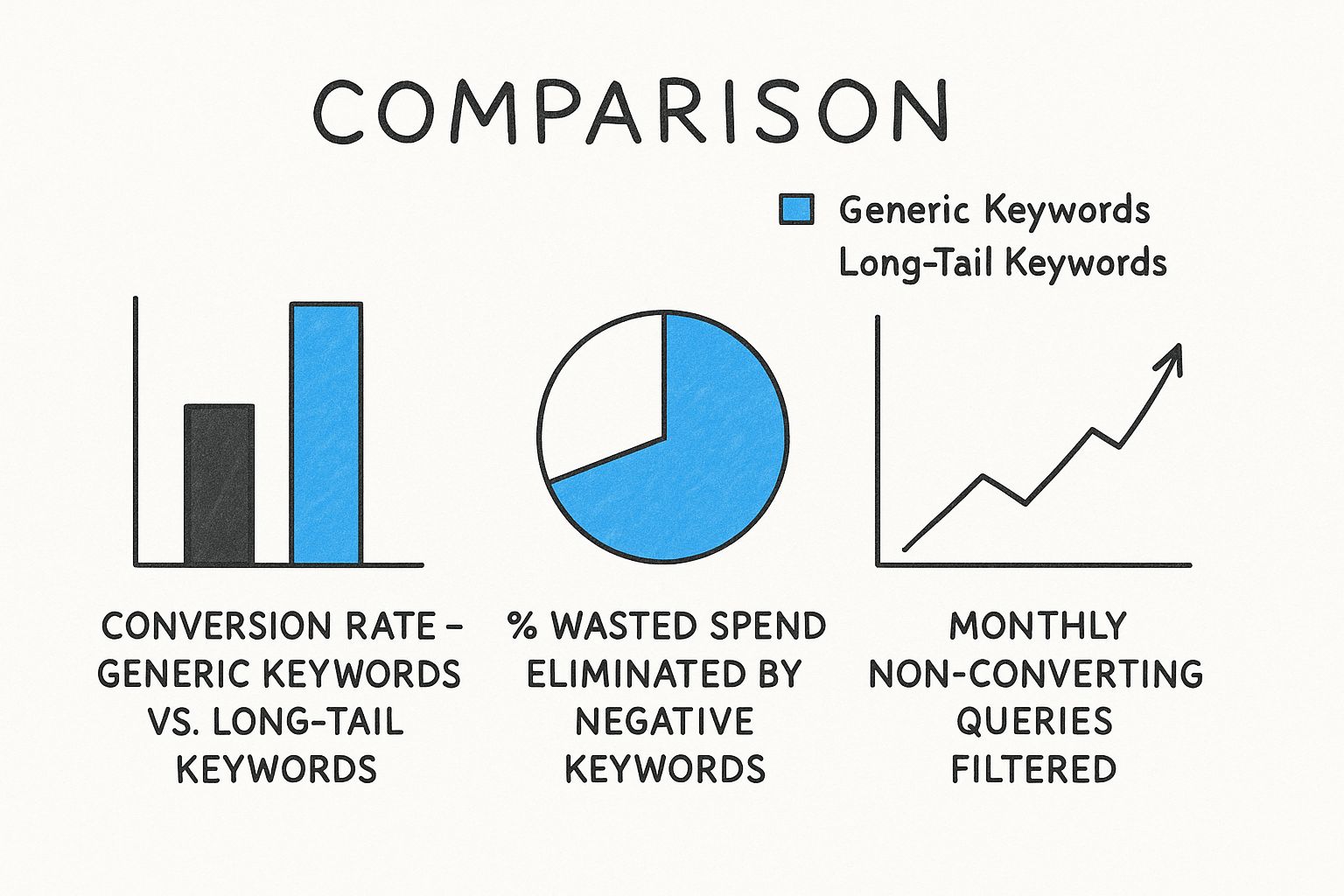
As you can see, zeroing in on long-tail keywords and blocking irrelevant traffic with negative keywords is a direct line to boosting conversions and plugging major leaks in your budget.
Mastering Negative Keywords to Stop Wasted Spend
Negative keywords are the unsung heroes of a profitable campaign. They act as a filter, preventing your ads from showing for searches that will never convert but will happily drain your budget. A meticulously managed negative keyword list is as critical as your targeted keyword list.
Let’s say you sell premium project management software. Without a solid negative keyword list, your ad for "project management software" could easily show up for searches like:
- "free project management software"
- "project management software resume template"
- "project management software tutorials"
Every click from those queries is 100% wasted ad spend. By adding terms like "free," "resume," "template," and "tutorials" to your negative keyword list, you instantly protect your budget and focus it exclusively on potential customers.
Your Search Terms Report is the most valuable tool you have for optimization. Make it a weekly habit to dive in, find those irrelevant search terms that are costing you, and add them to your negative keyword lists. This one discipline can fundamentally change your ROI.
Seriously, don't skip this. Reviewing this report is non-negotiable. It gives you a direct look into your audience's mind, letting you constantly sharpen your targeting and stop paying for clicks that go nowhere. It’s how you make sure every dollar works as hard as it possibly can.
Your Google Ads bidding strategy is more than just a setting—it’s the core instruction you give the algorithm. Get this right, and you'll have a powerful ally working to hit your business goals. Get it wrong, and you'll feel like you're burning cash with nothing to show for it.
The whole point is to align your strategy with what you actually want to achieve. Are you gunning for phone calls? Or are you trying to sell high-margin products? Each goal has a bidding strategy built for it.
https://www.youtube.com/embed/IJkPP_vxFk0
Aligning Your Bidding with Your Business Goals
Think of automated bidding as hiring a specialist for a specific job. You wouldn't ask an accountant to design your logo, right? In the same way, you shouldn't use a bidding strategy meant for brand awareness when your real goal is to get leads.
Let's break down some of the most common goal-oriented strategies.
-
Maximize Conversions: This one is simple and direct. You're telling Google, "Get me the most conversions you can within my daily budget." This is perfect when every conversion holds the same value for you, like a newsletter signup or a whitepaper download.
-
Target CPA (Cost Per Acquisition): Here, you get more specific. You tell Google the exact amount you're willing to pay for a single conversion. It's a fantastic fit for lead generation campaigns where you know precisely what a new lead is worth to your business.
-
Maximize Conversion Value: This strategy shifts the focus from the number of conversions to the total revenue they generate. It’s a go-to for e-commerce stores that sell products at wildly different price points.
-
Target ROAS (Return On Ad Spend): This is where you aim for a specific return on every dollar you spend. For example, an e-commerce brand might set a Target ROAS of 500%, which means they expect $5 in revenue for every $1 of ad spend.
A huge part of a successful Google Ads optimization plan is giving the algorithm enough data to work with. Before you even think about switching to a sophisticated strategy like Target CPA or Target ROAS, you need a solid foundation. You should generally have at least 15-30 conversions over the last 30 days so the AI has enough information to make smart decisions.
Don't jump into advanced bidding strategies without enough conversion data. You need to give Google's AI a fighting chance to learn, or you'll just end up confusing the system and wasting your budget.
Bidding Strategies in the Real World
Let's put this into practice. Imagine a local plumbing company that relies on emergency repair calls. Every single phone call is a high-value lead. For them, Target CPA is the perfect choice. After doing the math, they know a new customer is worth $300 over their lifetime, so they feel confident setting a $50 Target CPA to get that initial call.
Now, consider an online clothing store. They sell $20 t-shirts alongside $400 custom leather jackets. A t-shirt sale is nice, but it's not nearly as valuable as a jacket sale. If they used Maximize Conversions, Google might just get them a ton of low-value t-shirt sales. Instead, they should use Target ROAS or Maximize Conversion Value to signal to the AI that it should hunt for customers ready to purchase those bigger-ticket items.
To help you decide, here’s a quick comparison of the most popular bidding strategies.
Google Ads Bidding Strategy Comparison
This table compares popular automated bidding strategies to help you choose the best fit for your campaign goals.
| Bidding Strategy | Primary Goal | Best For | Key Consideration |
|---|---|---|---|
| Maximize Conversions | Volume of conversions | Lead generation where all leads have similar value; new campaigns. | Can drive up CPA if not monitored; doesn't distinguish between high/low value. |
| Target CPA | Cost efficiency per lead | Businesses with a clear, fixed cost-per-acquisition target. | Requires at least 15-30 conversions in the last 30 days to be effective. |
| Maximize Conv. Value | Total revenue | E-commerce stores with a wide range of product prices. | You must have conversion value tracking set up properly. |
| Target ROAS | Return on Ad Spend | E-commerce businesses focused on achieving a specific profitability target. | Prone to volatility if conversion data is sparse; can limit scale. |
Choosing the right one from this list comes down to knowing your numbers and what truly matters for your bottom line.
A major development in the Google Ads ecosystem is the growing power of Performance Max (PMax) campaigns. PMax uses AI to automate targeting and delivery across all of Google's channels. While powerful, it requires feeding the system with strong creative assets (images, videos, copy) and clear conversion signals. For e-commerce brands, pairing PMax with a detailed product feed and a Target ROAS goal has become a dominant strategy in 2024.
Writing Ad Copy and Using Extensions That Convert
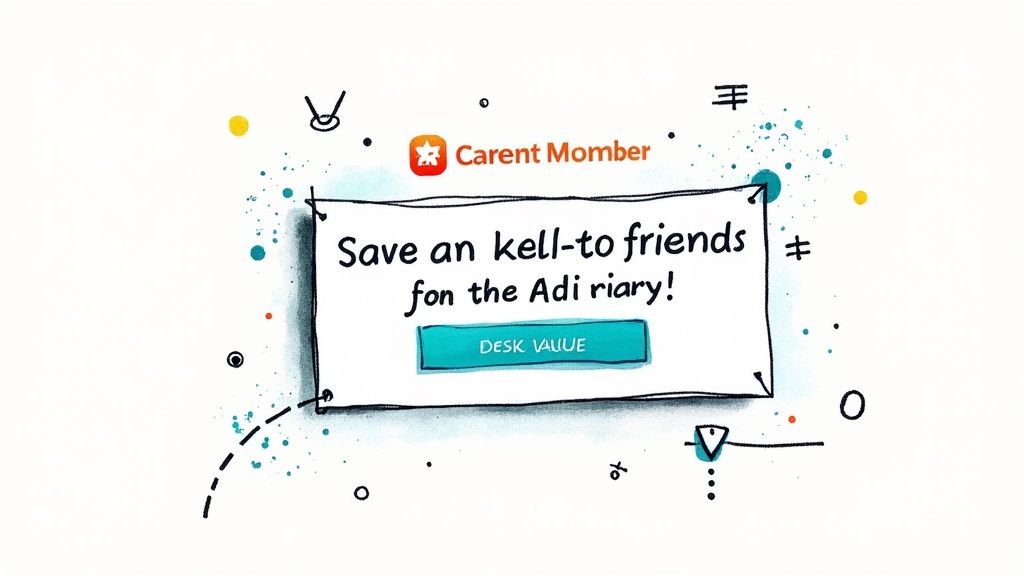
Think of your ad copy as the first handshake with a potential customer. It’s your one shot to grab their attention, show them you have what they need, and convince them to take the next step. It's not just about stuffing keywords in; it’s about crafting a magnetic headline, a genuinely helpful description, and a clear call-to-action (CTA) that all work together.
Getting this right isn't a "set it and forget it" task. The secret sauce is relentless A/B testing. You must constantly be running experiments with Responsive Search Ads (RSAs), pitting different headlines and descriptions against each other to let Google's AI identify the winning combinations.
Data shows that campaigns with "Excellent" Ad Strength in their RSAs see, on average, a 12% increase in conversions. This isn't just about following Google's recommendations; it's about providing the algorithm with a diverse set of high-quality assets so it can assemble the perfect ad for each individual search query. If you want to dive deeper into structuring your campaigns for success, these Google Ads optimization tips and best practices are a great resource.
Crafting Headlines That Command Clicks
Your headline is everything. It's the first—and sometimes only—thing people read. It must instantly connect with what they just typed into Google and promise a fast, relevant solution.
What makes your business the better choice? Is it your speed, your pricing, your quality, or a unique feature nobody else has? Put that front and center. A generic headline like "Plumbing Services" is invisible. Instead, test things like "24/7 Emergency Plumber" or "Clogged Drains Cleared Fast." See the difference? They're specific, benefit-driven, and practically scream "click me" to someone with a real problem.
Supercharge Your Ads with Extensions
If you want to dominate the search results page, ad extensions (now known as Assets) are your best friend. They enhance your ad with crucial business information, making it physically larger, more eye-catching, and more useful. Leveraging assets is a core part of any modern optimization Google Ads strategy because it's one of the few ways to improve your Ad Rank without simply bidding more.
Ad extensions don't just make your ad bigger; they make it more useful. By providing key information like your phone number, location, or special offers upfront, you filter out irrelevant clicks and attract users who are truly ready to engage.
There's an asset for almost every business goal, and the key is to use the ones that are most relevant to your customers.
- Sitelink Assets: These are your ad's navigation menu. Add direct links to important pages like "Pricing," "Case Studies," or "Book a Demo." They provide shortcuts to what users are likely looking for.
- Callout Assets: Perfect for short, punchy value propositions. Think "Free Shipping," "24/7 Customer Support," or "ISO Certified." They’re quick-hitting phrases that reinforce why a user should choose you.
- Structured Snippets: These let you highlight specific aspects of your products or services. A software company, for instance, could list "Features: Automation, Reporting, Integrations." It adds valuable context directly within the ad.
When you pair compelling copy with a smart mix of assets, your ad transforms from a simple block of text into a rich, informative answer to the user's query. This doesn't just improve your metrics; it starts building trust from the very first impression.
Make Sure Your Landing Pages Complete the Journey
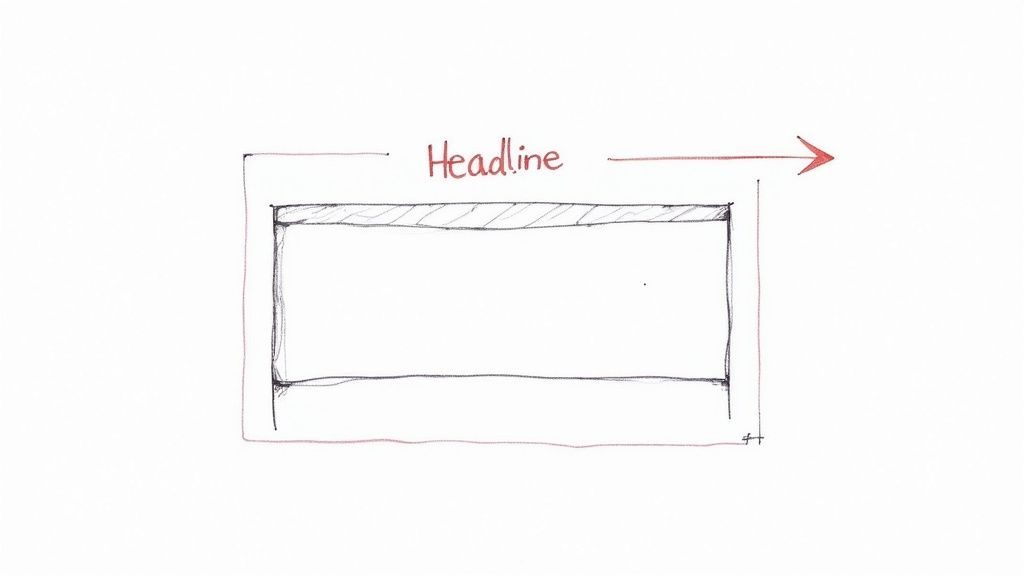
Your ad might be perfect, but it's only half the battle. The real moment of truth comes after the click. What users find on your landing page is a huge part of your Quality Score, and Google pays very close attention to it when deciding your ad rank and costs.
Think of it this way: a brilliant ad that dumps someone on a confusing, irrelevant landing page is like a great movie trailer for a terrible film. It’s a surefire way to burn through your budget. For your campaigns to actually work, the path from ad to conversion needs to feel like one smooth, logical step.
This connection is what we call "message match," and it's absolutely essential for any serious optimization Google Ads effort. The idea is simple: what you promise in the ad needs to be immediately visible and available on the page they land on.
The Critical Role of Message Match
Let’s say someone clicks on your ad for a "50% Off Spring Sale on Running Shoes." If that click takes them to your generic homepage, you've created a dead end. They were expecting a sale, but now they have to go searching for it. Most people won’t. They'll just leave.
That quick exit, or "bounce," tells Google your page wasn't a good match for the search. This hurts your Quality Score and makes your clicks more expensive. The fix is straightforward: make sure your landing page headline echoes your ad copy and the page's content delivers on the promise instantly.
Build Your Page to Convert
Beyond matching the message, your landing page design is a massive factor. This isn't about winning art awards; it's about clarity and ease of use.
- Create a Clear Path: Use headings, subheadings, and plenty of white space to guide the user's eye straight to the important stuff.
- Make the CTA Obvious: Your call-to-action (CTA) button should stand out. Use a color that pops and text that tells people exactly what to do, like "Get Your Free Quote" or "Download Now."
- Think Mobile First: The majority of your clicks will likely come from smartphones. Your page absolutely must load quickly and be a breeze to use on a small screen. According to Google, 53% of mobile users abandon sites that take longer than three seconds to load.
This focus on the user's entire experience has only gotten more important. A recent Google Ads update is the introduction of a new "Landing pages" tab, which provides more granular data on page performance and mobile-friendliness directly within the UI. This shows Google is placing even more emphasis on the post-click experience.
I saw this firsthand with a financial services client. Their ad was performing well, but existing customers were clicking it and then getting frustrated when they couldn't find the login button on the landing page. Those bounces were tanking their campaign performance. You can find more details about these kinds of shifts in Google Ads strategies on boomcycle.com.
A frictionless user journey isn't just a nice feature—it's a core requirement for a profitable campaign. Every bit of friction or confusion on your landing page directly inflates your cost-per-acquisition.
Treat your ad and your landing page as two halves of a single conversation. When you create that seamless experience, you're not just making users happy—you're sending all the right quality signals to Google. That’s how you turn clicks into customers and get a real return on your ad spend.
Common Questions About Google Ads Optimization
When you start digging into the nitty-gritty of Google Ads, questions are bound to come up. Every account is a little different, of course, but a lot of the problems advertisers run into are surprisingly common. Let's tackle some of the most frequent ones with clear, no-nonsense answers.
How Often Should I Actually Optimize My Campaigns?
Consistency is king. A weekly check-in is the sweet spot for most accounts. You don't need to live inside your Google Ads dashboard, but setting aside a specific time each week is a game-changer.
At a bare minimum, you should be doing two things every week:
- Digging into your search terms report to find new negative keywords.
- Checking your budget pacing and key performance indicators (KPIs) like CPA and ROAS.
Then, once a month, block off a bit more time for a deeper dive. Look at your overall bidding strategy, analyze asset performance in your Responsive Search Ads, and re-evaluate if your campaign structure still makes sense for your goals.
For large-scale accounts spending significant budgets, a quick daily check on pacing and anomalies is essential. For everyone else, this weekly and monthly rhythm keeps you ahead of the curve, so you’re making proactive tweaks instead of scrambling to fix a sudden performance drop.
What’s a Good Quality Score and How Do I Fix a Bad One?
You should always be shooting for a Quality Score of 7/10 or higher. Anything below a 5 is a major red flag that something is fundamentally disconnected, and you need to investigate right away. A low Quality Score directly increases your cost-per-click (CPC).
Improving your score really comes down to nailing its three core components:
- Ad Relevance: This one’s straightforward. Does your ad copy actually match the keywords in the ad group? If someone searches for "blue running shoes," your ad better talk about blue running shoes.
- Expected Click-Through Rate (CTR): This is all about writing ads that people genuinely want to click. Focus on the benefits, create a sense of urgency, and make your offer irresistible.
- Landing Page Experience: What happens after the click? Your landing page needs to load fast, be easy to use (especially on a phone!), and deliver on the promise you made in your ad.
Think of Quality Score as Google’s report card on your user experience. A high score tells Google you’re giving searchers exactly what they want, and in return, you get rewarded with lower ad costs and better placements. It’s a win-win.
Should I Still Be Using Broad Match Keywords?
Yes, absolutely—but with a strategic approach. Thanks to major improvements in Google's AI, broad match is no longer the budget-waster it once was. The key is to pair it with a smart, conversion-focused bidding strategy, like Target CPA or Target ROAS.
This combination transforms broad match from a blunt instrument into a powerful discovery tool. It allows Google's machine learning to identify new, high-converting search queries that you would likely never discover through manual research alone.
However, this strategy requires hyper-vigilance. You must commit to reviewing your search terms report frequently, especially in the first few weeks of a campaign. Be aggressive with adding negative keywords to filter out irrelevant traffic and guide the algorithm toward the most profitable searches.
Tired of manually downloading lead lists from your Google Ads campaigns? Pushmylead takes that task off your plate for good. It instantly sends lead info from your Search, Discovery, and YouTube lead form extensions straight to your email inbox. Get your leads in real-time and respond faster at https://www.pushmylead.com.
